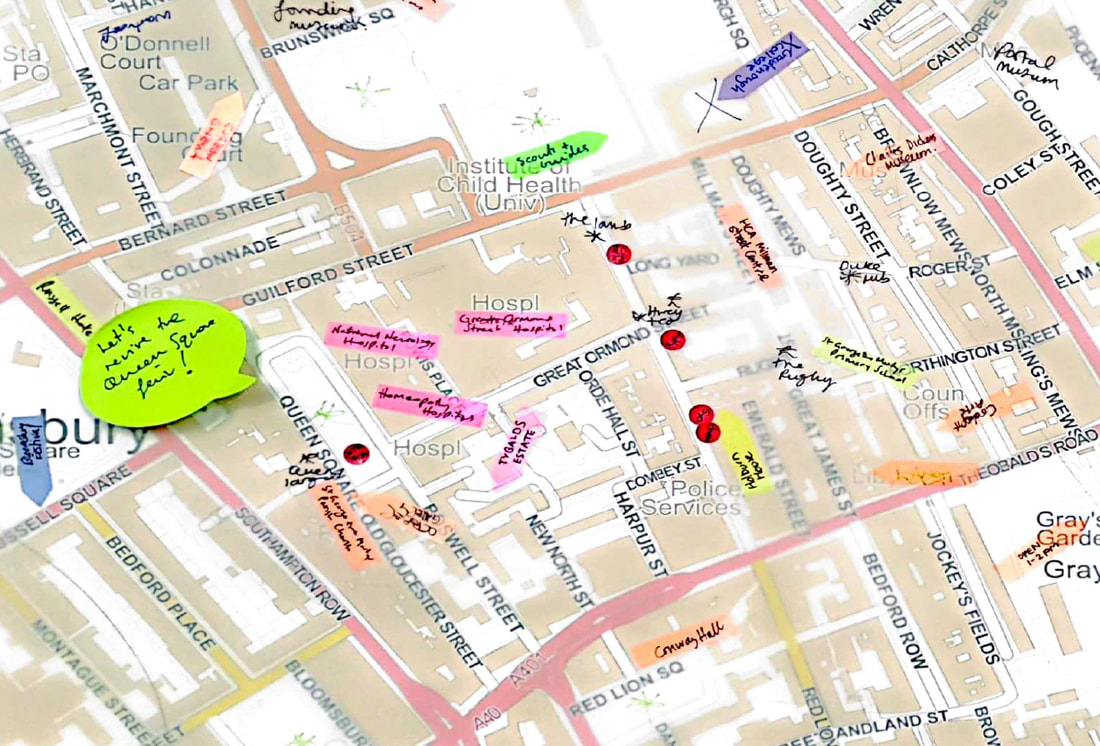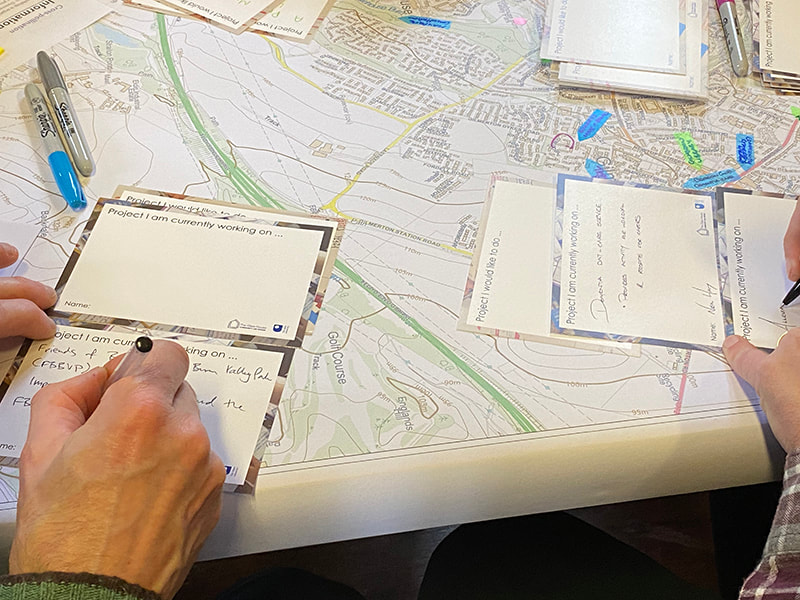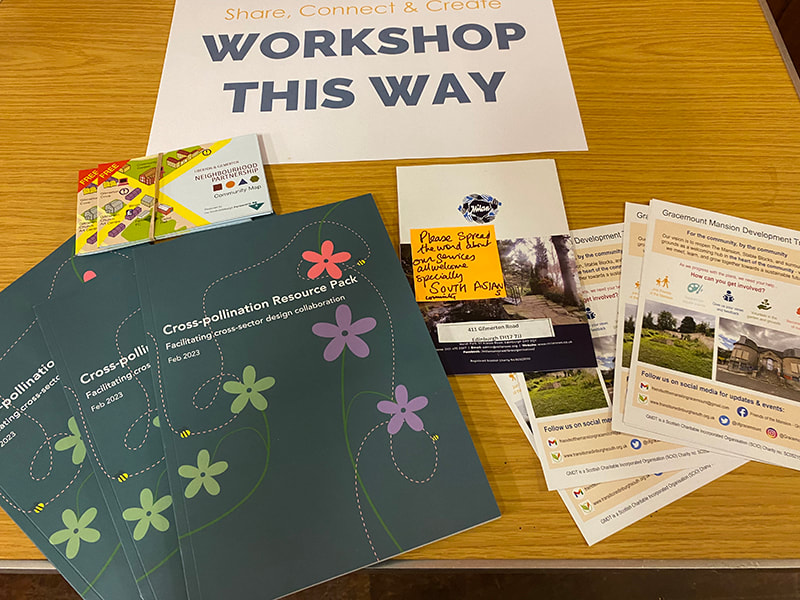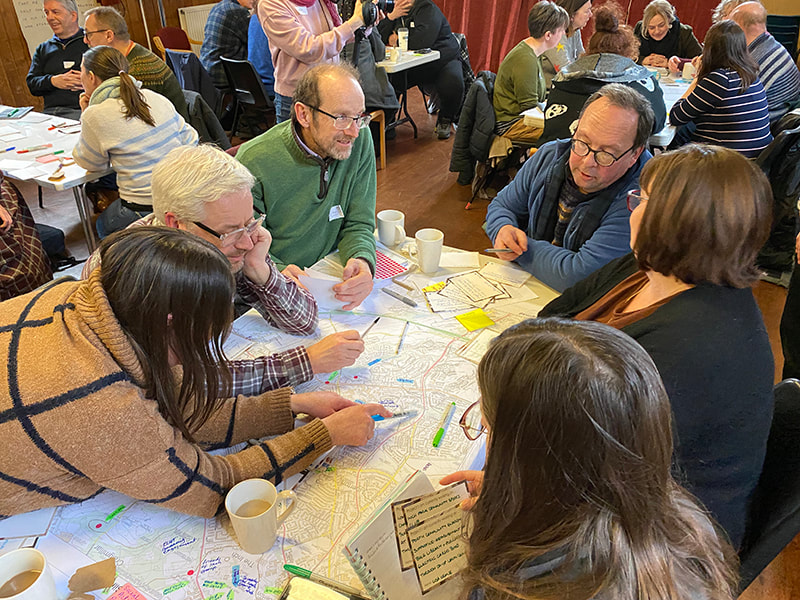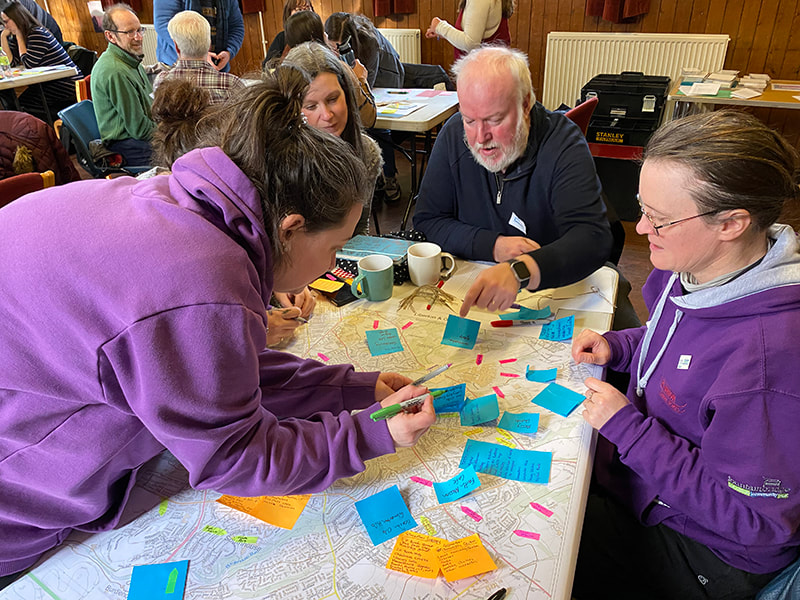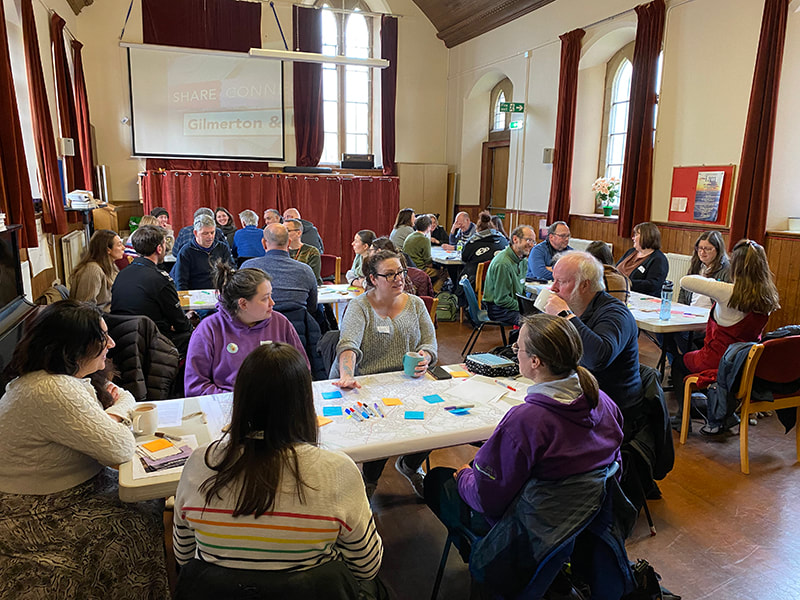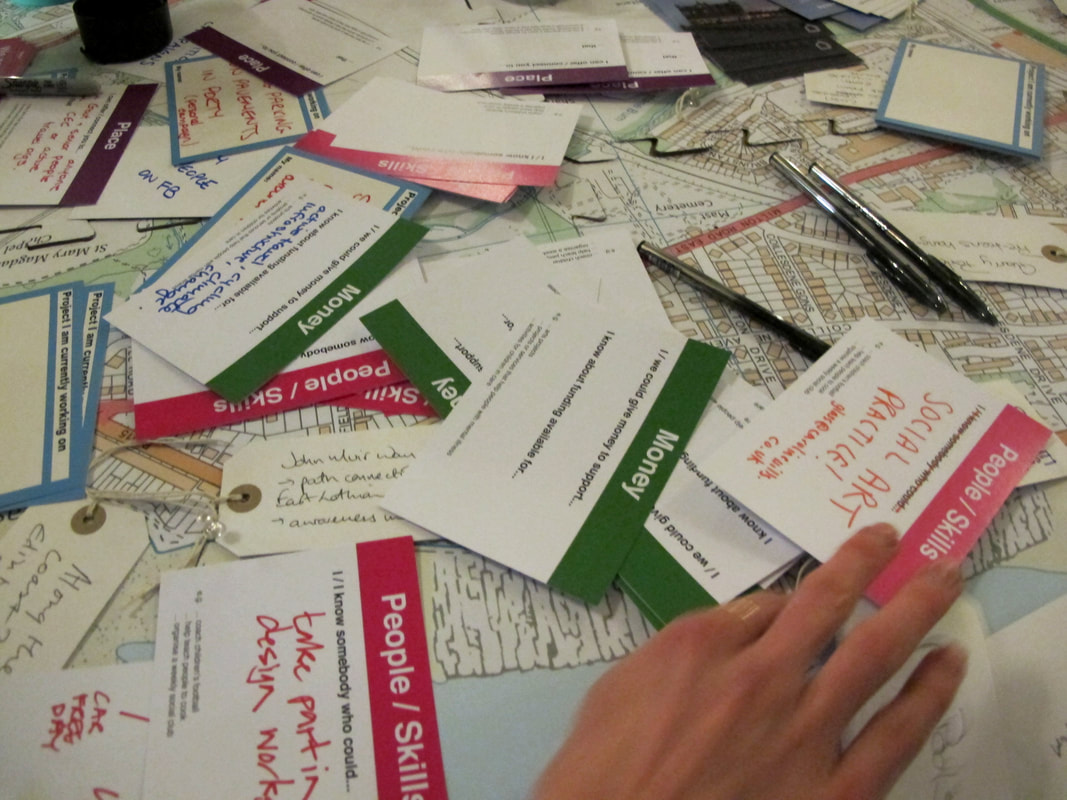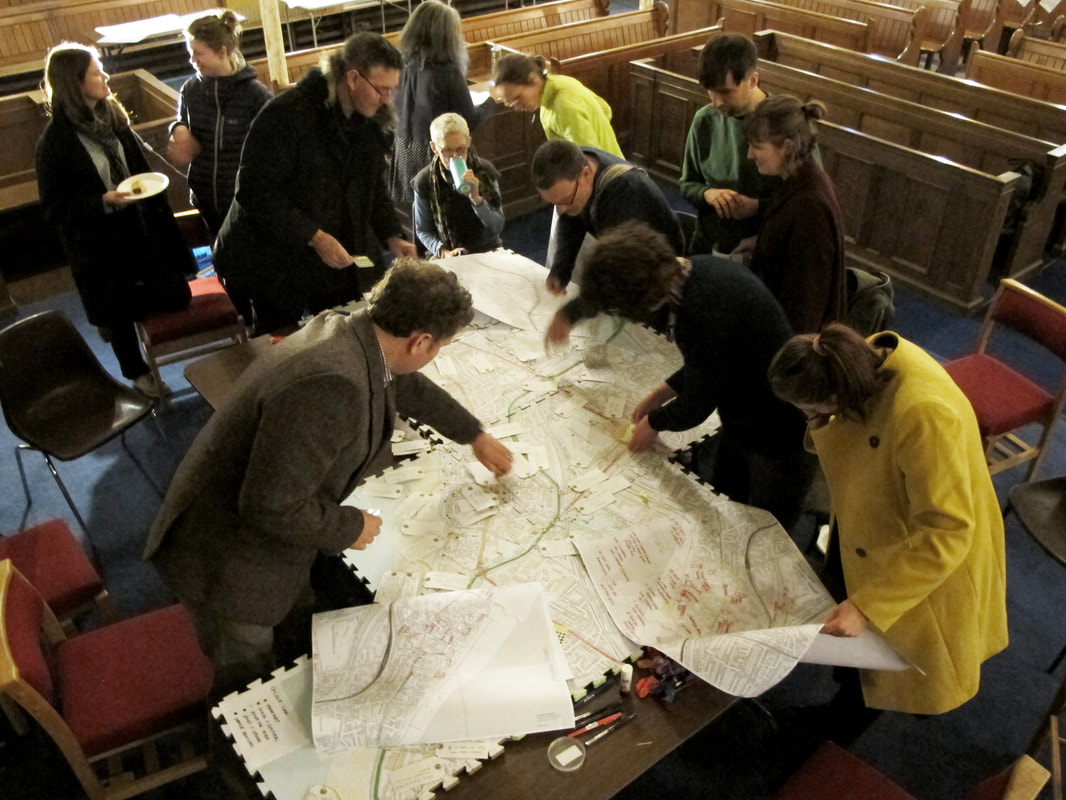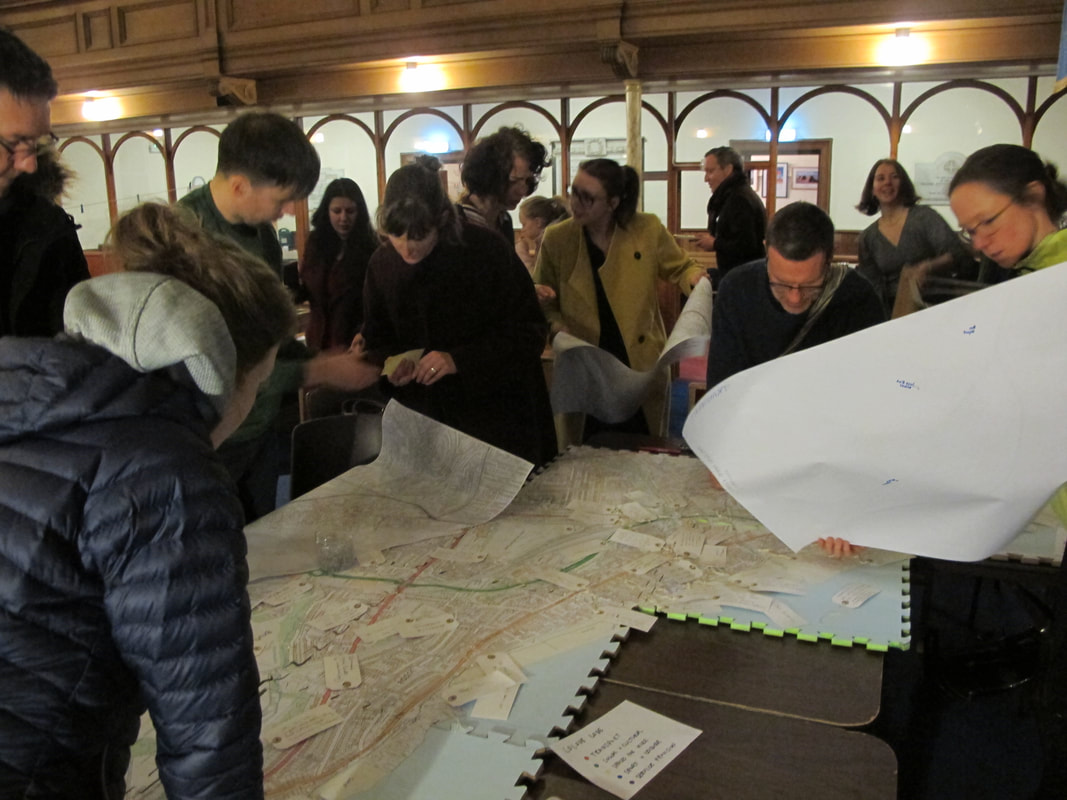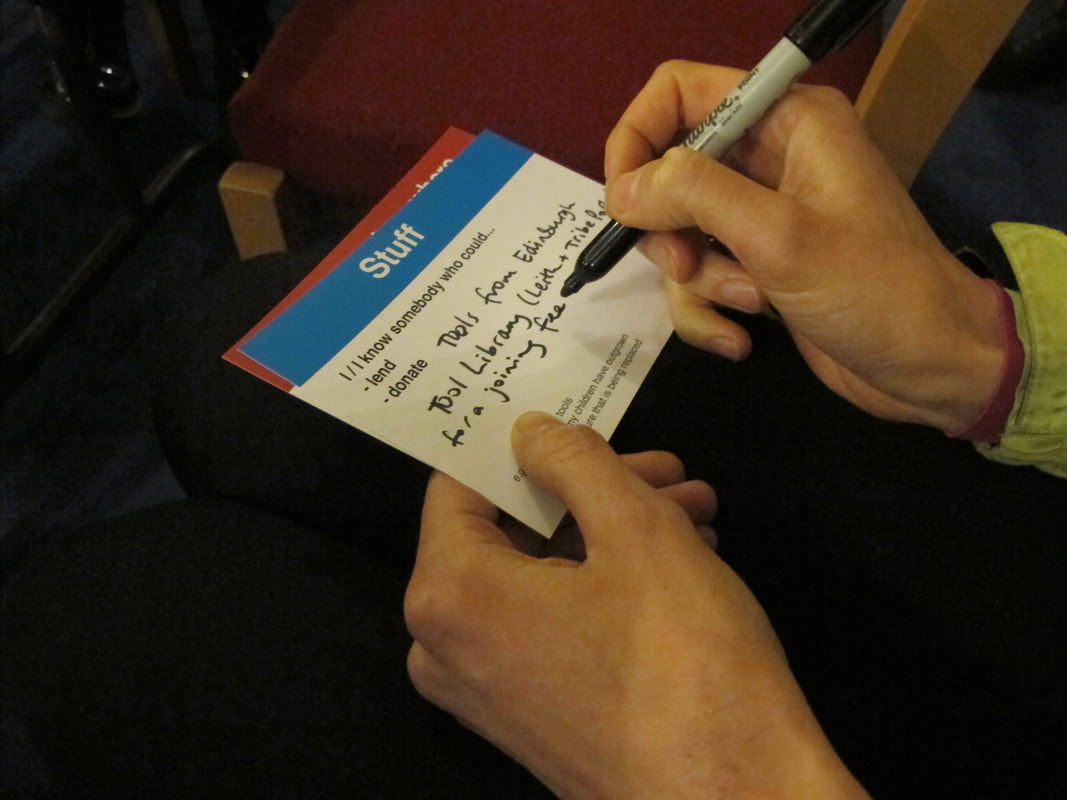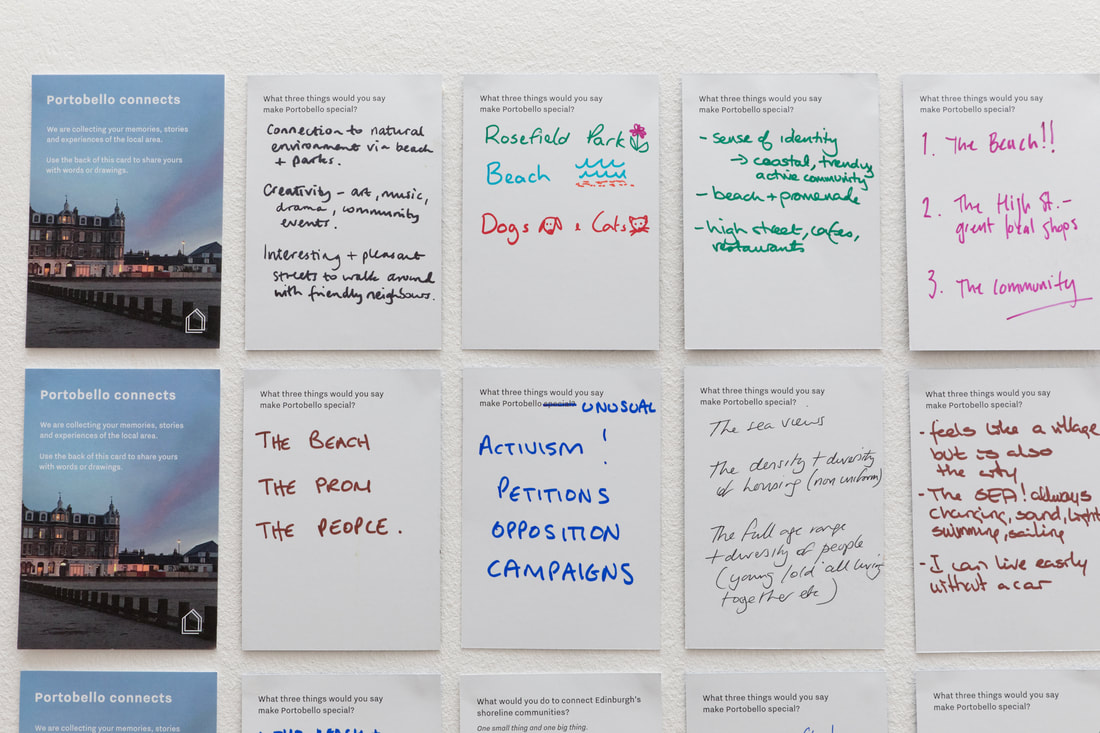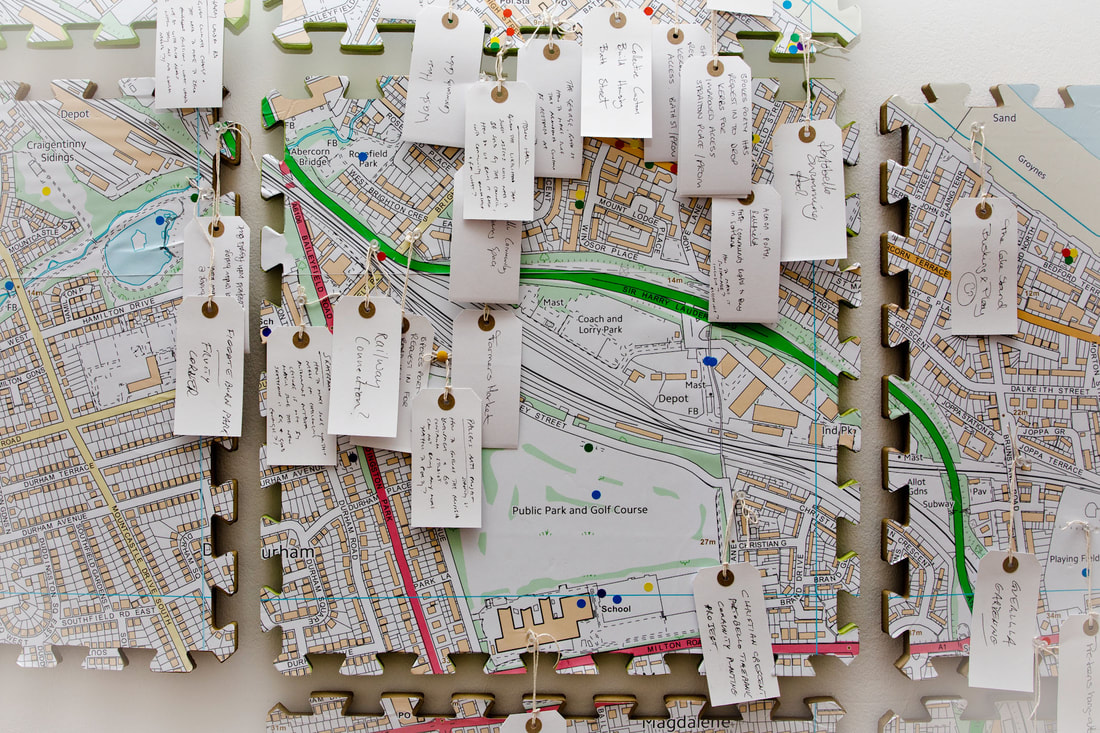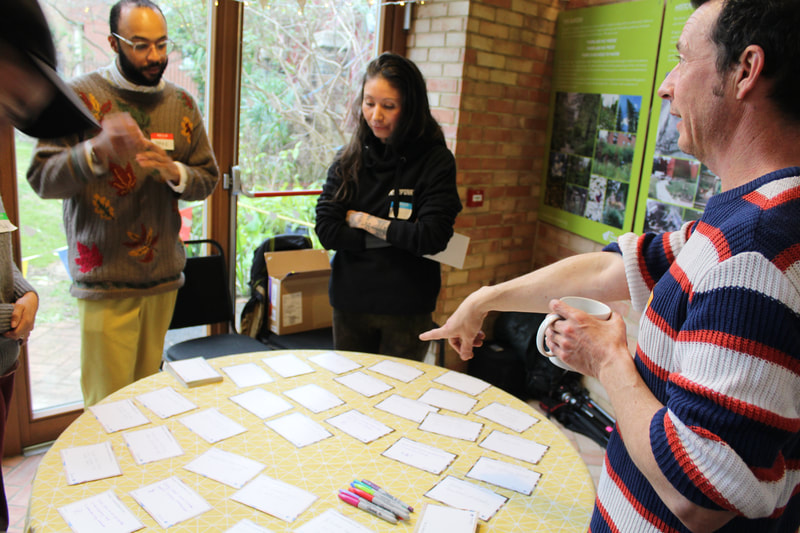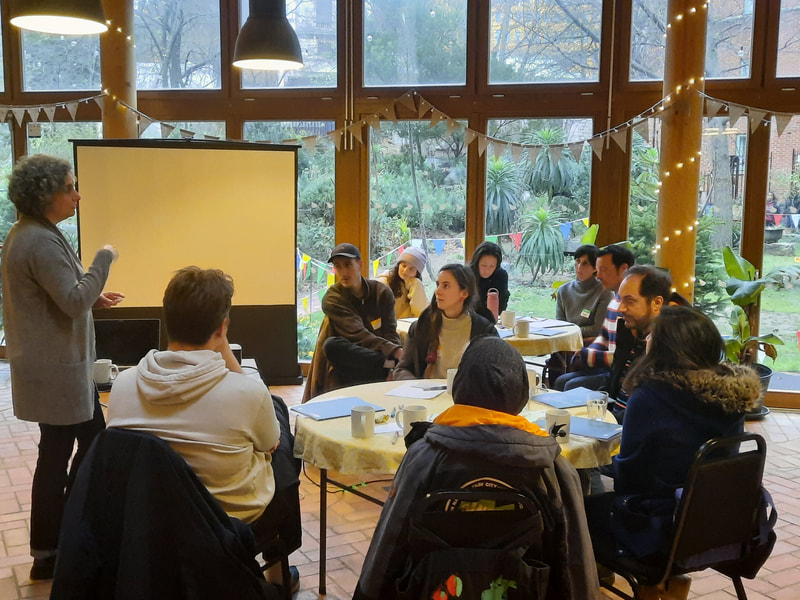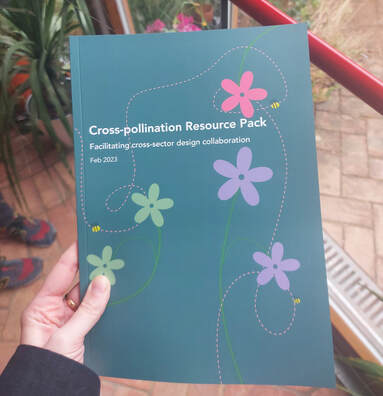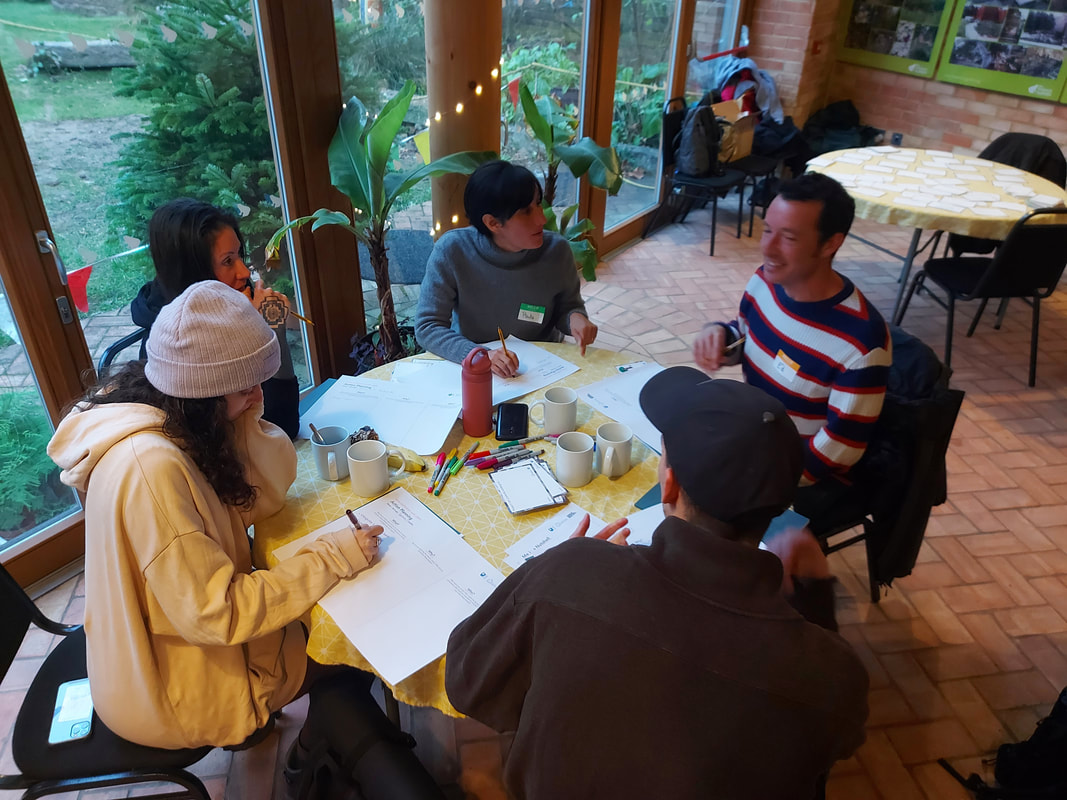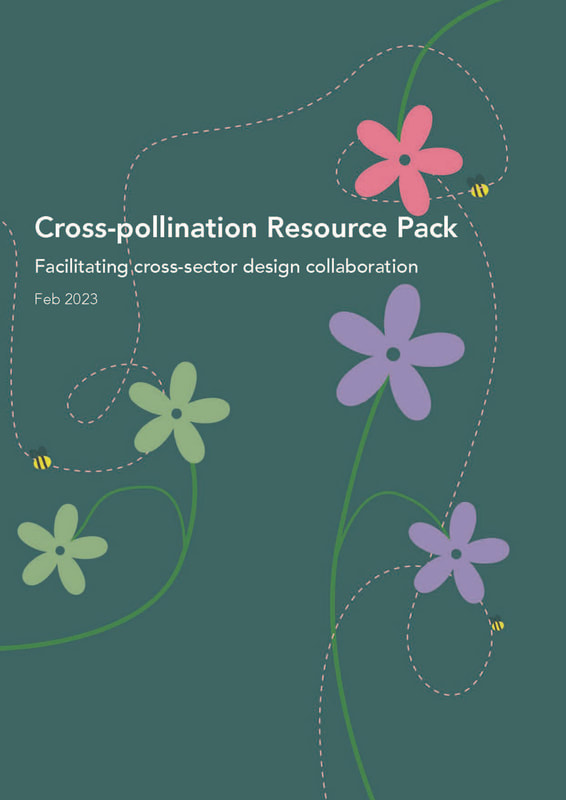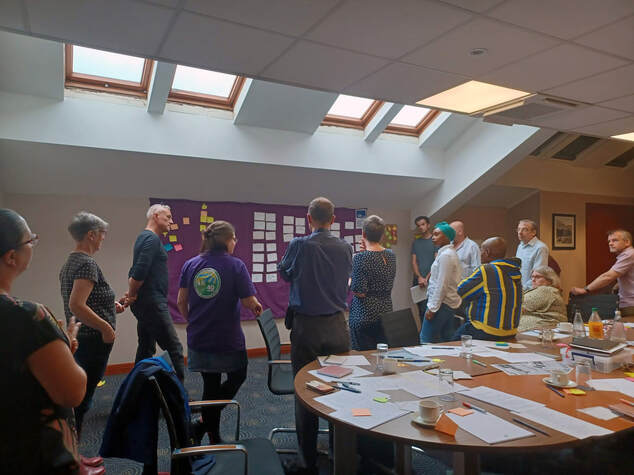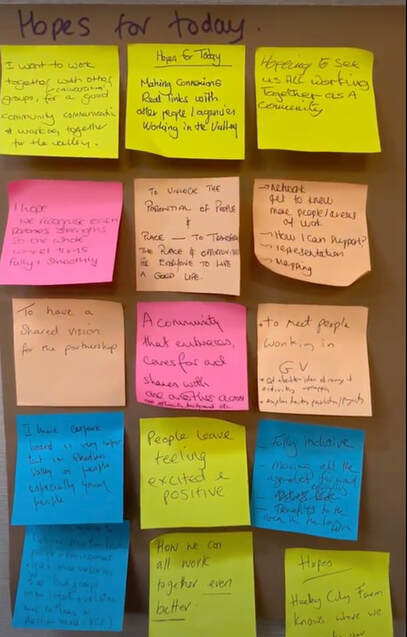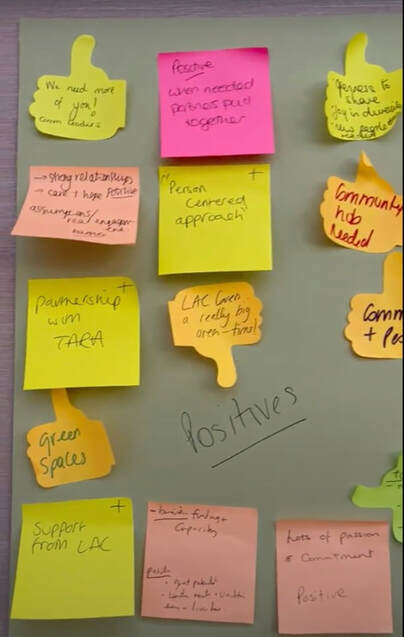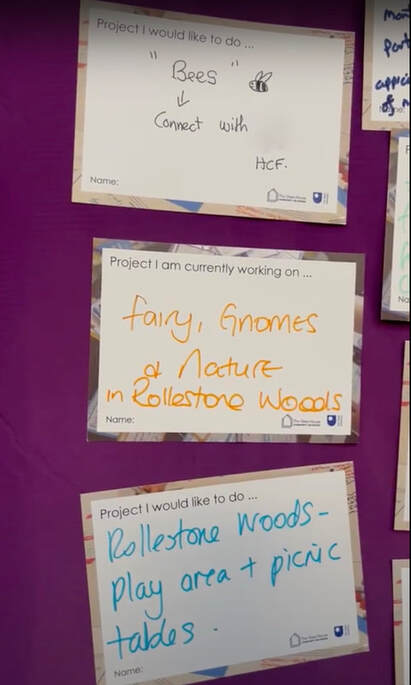|
While the Cross-pollination project funding under the Place Programme has officially come to an end, activity has not paused and the project's legacy is continuing to grow. The Cross-pollination team facilitated two cross-pollination workshops in the autumn of 2023 in two new locations in England. Each partner received a cross-pollination box, containing all the cross-pollination materials (the cross-pollination cards, the cross-pollination resource pack and a number of useful stationery items) necessary to facilitate further discussions and collaborations. The first workshop, in partnership with Holborn Community Association (HCA) brought together residents and various organisations active in this area of West Central London to initiate a fruitful conversation about planning, development and construction. You can read the post by the HCA Director, Paul Crozier, on The Glass-House Community Led Design blog: People Shaping Place. The second workshop was in partnership with Chichester Community Development Trust (CCDT), with whom we have worked before as part of a project called Empowering Design Practices in 2017. Back then, our collaboration was focussed on supporting plans for developing the historic Graylingwell Chapel as a resource for the local community (watch the story of Graylingwell Chapel). This time however, the aim was to use the cross-pollination approach in order to activate cross-sector collaboration across the district. You can read the post by the Head of Partnerships at CCDT, Claire Robinson, on The Glass-House Community Led Design blog: Connecting the Community Champions. These examples alongside all the ones we previously shared serve to show that cross-pollination can not only help incubate cross-sector collaboration in different contexts, and in a diversity of places nationally, but it can also support more long term plans, enhancing what is already happening, often reinvigorating connections, sparking new ideas and building confidence, to support the creation of meaningful and sustainable places.
Here is the latest in our collection of films, collating voices and perspectives across 3 of the locations the Cross-pollination project team work with, in Merthyr Tydfil, London and Edinburgh. Huge thanks to all the project partners and all the individuals, groups and organisations that took part in the project and continue to work collaboratively to support people and lead design initiatives in their places. We believe in the power of storytelling and film has been one of the key ways we used in the Cross-pollination project to convey people's stories and impacts, but also to inspire others to adopt and adapt cross-pollination to support collaboration in their place. A cross-pollination process can take many different forms, but it is often realised as a workshop bringing actors from different disciplines, sectors and backgrounds together to start a conversation about their assets and their places. Our latest film in the series is intended to work alongside the Cross-pollination Resource Pack and serves as a demonstration of the workshop process through four simple steps. The film was created during a cross-pollination workshop in Edinburgh in March 2023. We hope to see more people benefitting from this resource, if you're one of them, let us know! In both the research and the practice world, we often tend to perceive projects as a series of activities or events, and we only have an opportunity to collect feedback and capture impact within very short timescales. We often forget about what happens before (all the work that goes into setting up different activities, especially when these are co-designed with community based groups or organisations), but also after, when an activity or event is officially delivered and all co-researchers or participants presumably move on to the next thing. In reality, the collaborative research projects that we do, are not a series of isolated events or interventions. They build on longer histories of connections, and even when we work with new partners, the activities organised are embedded and form part of activities, projects and programmes that already exist or are in the process of emerging. More importantly, we see ourselves as enablers, so we approach co-design research as a vehicle for building the capacity of the network of people and organisations that we engage with, to continue collaborative design work. The impacts of the research are distributed and sprout out at different times and in different contexts. In the Cross-pollination project we had the opportunity, through an additional impact funding allocation, to support a cross-pollination exercise in Edinburgh, which had direct links with a previous cross-pollination workshop delivered by the project partners, The Glass-House Community Led Design, a few years back, in a different area of the city. This gave us the opportunity to capture the cascading aspect of cross-pollination, i.e. how people’s skills, capabilities and socio-spatial connections grow over time and influence policies, practices and the production of space. The film below aims to illustrate the cross-pollination approach and how it helps cascade and grow design collaboration within and across places in an organic way. It presents the experiences and observations of local people and organisations who participated in the cross-pollination workshop in the Liberton and Gilmerton area in Edinburgh, organised in collaboration with EVOC in March 2023. It also draws out the connections to the previous workshop in Portobello in 2019, capturing the longer term impact of the approach. We look forward to see where new seedlings will sprout in Edinburgh but also in all the other places we worked with as part of the cross-pollination project, in London, Sheffield, Glasgow and Merthyr. In this blog post, Charlie Wright shares his reflections from a cross-pollination workshop the team delivered in collaboration with Edinburgh Voluntary Organisations Council (EVOC) in the Liberton and Gilmerton area. Charlie is the coordinator of EVOC’s Climate Program which supports community, voluntary and social sector organisations across the city to deliver on Edinburgh’s ambitious Net Zero by 2030 Climate Goals. Charlie’s background is in Urban Design & Planning and he has worked with informal communities in a variety of international contexts. Charlie’s current focus is exploring the role of Community Wealth Building in unlocking a just and equitable transition to a net zero economy for Edinburgh. Why connecting people and mixing fun with delicious food is the key to transforming your neighbourhood in the new age of scarcity. Community development and engagement has become a lot harder. Since the Pandemic, our communities have been pushed to breaking point and have lost confidence that the current system will improve their lives. The ever-growing list of complex systemic problems is becoming unmanageable and even the most seasoned community development professionals are struggling to keep on top of the list of demands placed upon them. An alarming publication from the Community Life Survey this week confirmed that engagement in social action e.g. setting up new community groups and charities, running community campaigns, maintaining community services, organising community events, volunteering, civic engagement, and charitable giving is at the lowest level ever recorded - at just 12% of the population. Since the pandemic started in 2020, there has also been an equally concerning 7% drop in ‘people who would be willing to pull together to improve their neighbourhood’ (UK GOV: 01/05/2023). Why is this? It is no great surprise that with the cost-of-living crisis, decimation of living standards, combined with global crises like the pandemic and Climate Emergency that people are being starved of the luxury of time and headspace needed to get involved in community improvement activities. Ideally, both the current and next central government will invest significant resources to turn this negative trajectory around by both investing in communities and fixing our broken economy. However, the current reality is that if we want to fix this tailspin in community involvement soon, we are going to need some seriously impressive tools to re-invigorate communities and inspire people to put their shoulder to the wheel. As practitioners in community development, we need to be able to effectively communicate to communities that through their involvement, they can transform their own as well as their neighbours’ lives. This cannot be tokenistic; People need to be able to witness their impact and rediscover the notion that through collective activity change is possible. So, we need tools which are capable of moving communities into a space of collective shared activity, where participation has its own reward and where there is an immediacy of the sense of joy and impact. In essence, we need something which quickly injects a mixture of play, practicality, progress and some social magic back into the community. As practitioners, we need to comfortably operate and engage with the messy beginnings of community development, which are often looked on as “too involved” to the outsider. I am of course referring to the foundational activities of any community; coffee mornings, ceilidhs, book clubs and gardening groups. These activities are rarely acknowledged as an important part of community building, but they are the backbone and lifeblood of any community development process. The groups who run these kinds of activities often take years building trust and operate on extremely tight margins. They are the community’s main social assets, and they are important. We need to recognise the full pallet of social assets present within communities and move beyond the idea that there is one ‘perfect place-based community development organisation’ in every community. Successful community development involves an understanding of the importance of pluralistic local networks, nurtures collaborations and introduces tools which support collective action on local priorities. Fundamentally, we need to value approaches which can play football with the under 12s, dance tango with the over 60s, play frisbee on the beach with the 20 somethings and then bring them all together to decide to fix the broken swings in the local children’s playpark. Thankfully, in recent years, there has been a steady increase in the number of approaches which recognise the value of social assets and community ecosystems, which we can use to help bring communities together in a more socially meaningful way. Authors like Cormac Russell and John McKnight, the writers of “the Connected Community: Discovering the Health, Wealth and Power of Neighbourhoods” and Priya Parkers author of “The Art of the Gathering” have shared ideas and techniques which celebrate the importance of unique gatherings, building social connections and movement through recognition and joy of sharing each other’s gifts. These are asset-driven approaches, and they are fantastic! The Glass-House Community-Led Design and their strategic partners The Open University have developed their own socially created asset driven methodology called ‘Cross Pollination’ and it is a wonderful example of a simple and easily repeatable ‘Connecting Tool’. Their approach doesn’t just focus on the activity of bringing people together but also creates a special event around it with amazing food and workshop materials. In Edinburgh, we had the chance to give the Cross-Pollination methodology a go earlier this year. At Edinburgh’s Voluntary Organisations Council (EVOC), we began to recognise the deep need for people to come together socially and to rediscover their community connections before they could effectively tackle huge issues like the Climate Emergency and the Cost-of-Living Crisis. We contacted Sophia from The Glass-House last year and were fortunate enough to be able to invite The Glass-House and Open University team to one of the community areas in Edinburgh. We felt that the area in question needed help, and an opportunity for collaboration was created through their Cross-pollination research project, funded by the Arts and Humanities Research Council. We chose to run the Cross-Pollination workshop in an area of the city where there are a good number of community-based organisations but where there was little by way of shared activity between them all. The combined Gilmerton and Liberton area was a part of the city which needed to develop better connections between people organisations and local priorities. Sophia and Katerina arrived in early March to help deliver a day-long workshop using the Cross-pollination approach, where community organisations learn how to connect and share what they're working on and discover shared priorities, activities, and points of interest within the community. With a very packed room and a fantastic meal provided by Bridgend Community Farmhouse Trust, we were able to see the wealth of assets and connections available in the room as well as have time to discover new ideas over dinner. From this we have been able to understand a small portion of the scale of assets, offers, and collective ambitions within Liberton and Gilmerton. We are excited to explore how we can continue to deepen the Cross-pollination process, spread it more widely and develop catalysing activities across the community, where local groups and residents can get involved in a set of transformative projects which bring people together in common cause. The learnings from this process and similar asset-based approaches have given our team a fresh perspective on tools and methodologies available which can build new social connections and support collective action in neighbourhoods. It is often suggested that for us to tackle the Climate Crisis and other global issues, we need to confine individualism to the past and rediscover how to work together collectively. So, if we are to move beyond this decline of community involvement and face the big issues of today, we need to broadly restore the importance of community building activities in our work. To do this, we need to acknowledge social assets and prioritise the creation of connections between people. Our work needs to value the formation of lasting friendships across groups, residents, and practitioners. Community development really shouldn’t feel like a drawn-out, complicated process, it should feel like a series of very memorable parties and gatherings where good things happened, and where people really got to know each other. Some of the best ways to do this are by using approaches like ‘Cross-Pollination’, and the ‘Connected Communities’ where good food, fun and action can be brought together in a delightfully cosy way. Edinburgh Voluntary Organisations’ Council (EVOC) has been supporting the people and communities of Edinburgh since 1868. They do this by supporting, developing and promoting the interests and work of voluntary and community organisations across the City. EVOC is part of Edinburgh’s Third Sector Interface (TSI), or Council for Voluntary Service in England (CVS). CVS and TSI organisations have an important and often overlooked role in community development as network builders, conduits for specialist support and local advocacy.
In this blog post Sophia de Sousa, Chief Executive of The Glass-House Community Led Design, looks back at a Cross-pollination event the Glass-House delivered back in February 2019 in Portobello, in Scotland and reports on its legacy and impact. Portobello Connects as a space for innovation Back in February 2019, The Glass-House worked with Architecture & Design Scotland to offer a free, public-facing event called Portobello Connects, in the coastal community on the shoreline of Edinburgh. The event was part of our first national WEdesign event series, which marked an evolution from our longstanding Glass-House Debates series, which brought together speakers and audiences for discussion and debate, to a format that also integrated a hands-on collaborative design task. Our intention was to create a more playful route into discussion than the traditional speaker format had offered and also, very importantly, to create a mechanism to introduce people to the power of collaborative design processes that bring together diverse people, organisations and interests in placemaking. Portobello Connects was also the first time we had used our cross-pollination approach to support a place-based conversation. It brought together a diverse group of local people and organisations to talk about their area, share information on their projects and initiatives, and to explore mobilising their individual and collective assets through collaboration. The cross-pollination approach emerged from our Scaling Up Co-design research project back in 2013/14. We were exploring how best to support collaboration across our research team, which included our Strategic Partner The Open University, along with other higher education partners and a diverse range of small not-for-profit organisations. Although the team shared some key objectives, we also worked in a variety of ways, with different specialisms, and with huge differences in the context in which we were working, as well as in the scale and associated resources at our disposal. Cross-pollination was our way of putting the pieces of our puzzle together and helped our research team enormously. After the project, we shared the approach within the research community and experimented with it as a tool to bring together different stakeholders in placemaking. Portobello Connects was the first time we took cross-pollination into a community to bring people together to talk about a specific place. Portobello Connects was a bit of a light-bulb moment for The Glass-House. We were amazed by how quickly and effectively the diverse event attendees began working together to map their local area, share information and to explore collaboration. We saw established power structures and siloed thinking give way to a spirit of generosity and collaboration. Those who took part were amazed by how much they discovered that they hadn’t known about their area, and by the wealth of interesting initiatives, people and organisations within their community. They also enjoyed the space we had created to have a conversation about their neighbourhood which was not focused on a specific regeneration scheme, housing development or planning policy, but was simply a conversation about the area they shared. Experimenting with Cross-pollination After Portobello Connects, we knew that we had to experiment more with this model, and since then have integrated the cross-pollination approach into much of the collaborative research we have been doing with our partners The Open University. It is of course at the heart of our current/recent project, Cross-pollination: supporting cross-sector collaboration in design and placemaking. Four years after Portobello Connects, our research partnership returned to Edinburgh last month to deliver a cross-pollination workshop in collaboration with EVOC, to support a place-based conversation in Liberton and Gilmerton. This collaboration had emerged because our key contact at EVOC (Charlie Wright) had heard about Portobello Connects, had been inspired by it, and he thought that it might be a useful approach to help support one of the areas in which EVOC is working. We were able to integrate a partnership workshop into the cross-pollination research project to offer Share, Connect Create: Gilmerton & Liberton. Reconnecting with Portobello Connects Participants While in Edinburgh, we thought we’d also take the opportunity to check in with a couple of people who had taken part in Portobello Connects, to look back on their memories of the experience. We were fortunate to catch up with Ian Gilzean, who until recently was the Chief Architect for the Scottish Government, and with Frazer McNaughton, a member of the Community Council for the area. We were pleased that not only did they have positive memories of the event, but that Portobello Connects had contributed in some way to subsequent placemaking conversations and collaborations. Here are some of the highlights of our conversation with Ian and Frazer: Inspiring new ways of working We were delighted to hear from Ian that attending Portobello Connects had inspired him to take elements of the cross-pollination approach and collaborative placemaking into work he has done both within the Scottish Government and while on secondment to Edinburgh City Council. At the time of Portobello Connects, the Scottish Government had been doing some work with Architecture + Design Scotland around co-design and co-production using design charettes, so Ian was already tuned into the notion of collaborative placemaking. However, what had struck him at Portobello Connects was our use of mapping as a tool to identify, celebrate and connect the positive things happening in the area. Rather than starting with identifying problems, or asking people to consult on a particular scheme or policy, our approach was to create a space for people to share projects and stories and as a means of opening up a broader place-based conversation which starts with local voices and stories. One of the aspects of that approach that had stayed with him, was what bringing a more open and collaborative place-based conversation had done to increase the diversity of voices, to unleash creativity and ambitious thinking and to increase the potential for local people and organisations to meaningfully help shape and share decision-making. Creating the right atmosphere Both Ian and Frazer spoke of the importance of creating a comfortable and welcoming atmosphere to support conversations which were not rooted in decision-making, but instead an open and creative space to explore ideas. Ian had been struck by people of diverse ages, backgrounds and roles within their community stepping into that space and working together as equals. Local volunteers leading small, local initiatives had the same space and were valued in the same way as professionals representing large organisations or government institutions who so often hold the power in traditional placemaking engagement activities. Portobello Connects invited everyone to put their ideas, initiatives and assets together to explore what they could do together which was not possible to do alone, and how collaboration might enrich what they were already doing. This was a space in which all were welcome and valued. He transposed that “what if?” approach into work he was doing in Wester Hailes, and in particular, as a way to empower young people to bring their creativity and ideas into exploring what was possible there. Frazer spoke of the power of working together through a set of hands-on activities to create a space for both collaboration and creative thinking that felt different from traditional meeting environments. He remembered that during the conversation, we spoke about mapping Portobello not only through a lens of physical infrastructure, but also through that of experiences, activities and relationships, and that this changed the dynamic of the conversation. The value of considered resources Frazer also spoke of the importance of the resources we brought into Portobello Connects. As well as using our asset cards, we had playful voting activities using jars and marbles to explore and compare people’s association with the city, the neighbourhood and the shoreline. We had evocative postcards for people to share their stories and memories of Portobello and the shoreline. These were prompts for discussion, but also offered people quiet reflective spaces to think about their own relationships with their area. Our then Design Champion Grace Crannis had lovingly crafted a large map which turned out to be the real centrepiece for discussion and both a practical and beautiful tool for our mapping activity. This was a practical and tactical prop for the event activities and a resource we could leave with the community. It was a large transportable map mounted on foam play mat puzzle pieces, which was practical for the workshop, but also easy to dismantle and reassemble. We were absolutely delighted to hear the Community Council has continued to use this prop for conversations about the area, and that they plan to use it for the emerging engagement activities around the 20-minute neighbourhood. A conversation that we hope will continue We are hugely grateful to Ian, Frazer and Charlie for sharing their reflections with us, as well as to all of the people who originally attended Portobello Connects. We were invited into a community to meet local people who so generously shared their stories, experiences and ideas by sitting down with others for an informal and exploratory conversation. We are so glad to hear that others remember the event fondly and that it has helped in some way. We, ourselves, learned a huge amount from the experience. We also want to celebrate the Bellfield and Action Porty which hosted us for both Portobello Connects and for our return visit. Find out more about how the community in Portobello took ownership of Bellfield Church via the Community Right to Buy Scheme here. We look forward to further collaborations with EVOC and with the people and organisations of Portobello and Edinburgh, with Architecture + Design Scotland, the Community Council, the City Council and the Scottish Government, with everyone who joined us at Portobello Connects who would like to carry on the conversation. London National Park City (LNPC) is a grassroots movement aiming to make London greener, healthier and wilder. They support a network of locally based Rangers across the city to connect and support thousands of people leading change in their own neighbourhoods. One of the Rangers who delivered a cross-pollination workshop in Barnet, Becky Lyons, connected us with Ed Santry and Mark Cridge from LNPC, who were interested in exploring the cross-pollination approach with a wider group of their Rangers. Thus, on Saturday 11 February 2023, the cross-pollination project team delivered a workshop with a group of 10 LNPC Rangers working across Greater London, at Phoenix Garden in Soho. Our afternoon workshop explored the cross-pollination approach, helping the Rangers consider how they could implement the ideas, methods and tools in each of their local areas. Although many of the Rangers had worked together before through previous LNPC activities, there were some new connections in the room alongside the research team. In order to break the ice and get to know each other a little better, we started the afternoon by inviting each participant to write 10 words, to introduce themselves and their reasons for being a Ranger. We then split the Rangers into two groups, taking them through the steps of the cross-pollination approach, which uses an asset-based perspective to highlight and value participants' existing connections and skills. By inviting the Rangers to step into the workshop as active participants, we shared the cross-pollination ideas and approach through doing. Our hope is that by allowing each Ranger to experience cross-pollination, they will then be able to develop and adapt it for their own areas and communities. This also offered an opportunity for this group of Rangers to connect their assets (projects, people and places), and discuss future project ideas. This allowed the Rangers to explore the synergies between each other's work.
The resource draws on our learning from this project, as well as previous research and knowledge exchange projects that have used cross-pollination in a variety of contexts. The A4 booklet provides a brief introduction and context to cross-pollination, examples of where and how it has been used before, and a practical guide to using the cross-pollination approach in a workshop. Action planning After having experienced cross-pollination in action, and having had a brief exploration of the Cross-pollination Resource, we invited the Rangers to use these ideas and themes to consider how they could apply the approach in their own local areas, or with their communities of interest. We used an action planning sheet, asking them to define ‘what’ (the theme and place their workshop would explore), ‘why’ (this theme is important and why they need their communities voices) and ‘who’ (they need in the room, and how they might be able to bring in a variety of voices). We hope that by providing Rangers with an introductory workshop, the Cross-pollination Resource and a short action planning session, the Rangers were able to leave the workshop feeling equipped and inspired to use the approach in their own localities to generate and enable cross-sector collaboration in placemaking. Film-maker Emma Crouch joined us for the day at Phoenix Gardens, and you can watch her beautiful capture of the day here. Blog post by Elly Mead, Design Champion, The Glass-House Community Led Design
On the 11th of February 2023 the cross-pollination project team delivered a workshop bringing a group of London National Park City rangers together to explore the cross-pollination approach, and start developing ways to adapt and use it to support collaborative work in their local areas. The film produced by Emma Crouch captures the event and the team's and participants' thoughts about this collaboration. An important objective of the Cross-pollination project has been to develop ways to help cascade and enable cross-pollination across locations, disciplines and sectors, in order to enable inclusive and sustainable placemaking processes and outcomes.
Drawing on what we have learned through this and previous research and knowledge exchange projects using cross-pollination in a variety of contexts, we developed a booklet which provides a brief introduction to the cross-pollination approach, examples of where and how it has been used to date, and some practical tools to help others use cross-pollination in their work or area. We hope that the resource will be valuable to anyone interested in exploring the value and mechanisms of collaborative working and in applying them in their local project, however big or small. This includes community leaders, community engagement professionals, voluntary organisations, local authorities, businesses or members of public bodies supporting placemaking. The booklet was designed so that it can be read online, but it also contains materials which can be printed out and used in a workshop context. More specifically:
We welcome your views about the resource, particularly if you are planning to adapt and use it. Click on the image below to download: Gleadless Valley was formerly a rural area, which was developed as a large housing project of over 4,000 dwellings, between 1955-62 by Sheffield Council. Gleadless Valley has many assets, including a strong local community, its proximity to the city centre and the local green spaces and woodlands. However, it is an area that experiences high levels of poverty and associated issues in terms of health and wellbeing, education and employment and crime and ASB. The area has a fragile infrastructure in terms of the voluntary, community and faith sector. This was exacerbated by the collapse of the local hub organisation, Reach South Sheffield in late 2020. Which left a further gap in the area, both in terms of delivering services for local people (including the local library) and providing support for other small community groups and organisations. The Gleadless Valley Partnership includes a number of groups formed to oversee a capacity building project in the area for which Sheffield Council secured a modest amount of funding. The groups involved in the partnership are Gleadless Valley TARA, Gleadless Valley foodbank, the 2 local churches, Holy Cross Church and Gleadless Valley Methodist Church, Heeley City Farm and Heeley Trust. However, in the past 12-24 months, to a great extent due to the pandemic, the partners have not all been able to meet regularly. The Cross-pollination project was seen as an opportunity to help the organisations who make up the partnership (and broader stakeholders including the council, police, local businesses) understand more about what their own strengths, assets, aims and priorities are, and how they come together to create a shared vision for the partnership going forward. The community capacity building project provides an opportunity for the partnership to take their relationship to another level in terms of working together to build a more sustainable future for the Gleadless Valley Community. Three members of the partnership attended a cross-pollination session delivered by The Open University and The Glass-House Community Led Design which introduced the approach, and its main principles and mechanisms. The partnership was then provided with a set of materials and seed funding to run a cross-pollination workshop at a venue in Sheffield. An independent facilitator from Voluntary Action Sheffield was commissioned to help run the workshop. The workshop was attended by 18 participants who started the conversation by sharing their hopes for the day, all by and large centered around collaborative working and unlocking people’s strengths and potential. Next, using the cross-pollination cards provided by the Cross-pollination project team, participants discussed the projects they were already working on or would like to do. Finally, to help facilitate thinking about their collective skills, resources, connections and places, the group first agreed their top 3 priorities to focus on. These were: the Gleadless Valley Festival; Community Hubs; and Activities for Young People & Families.
Following the workshop the partnership started planning the community festival for next summer and planting the seeds for the connecting hubs project. The community capacity building project starting at the end of 2022 - beginning of 2023 is expected to provide some additional community development capacity to support the Partnership to continue to grow and develop a community plan where the values and ethos of cross-pollination will continue to be embedded. The following bullet point offer some reflections on the outputs and outcomes of the cross-pollination approach:
Thanks to Diane Owens, South LAC Manager for providing the information for this blog post. |
